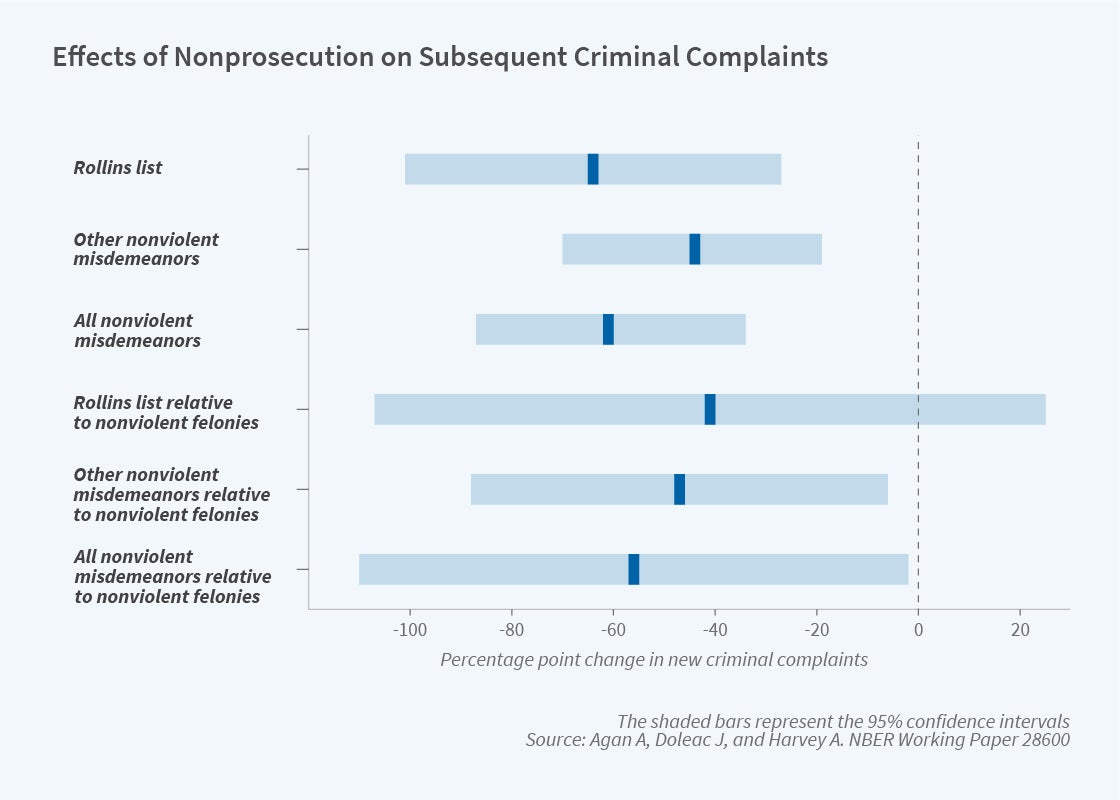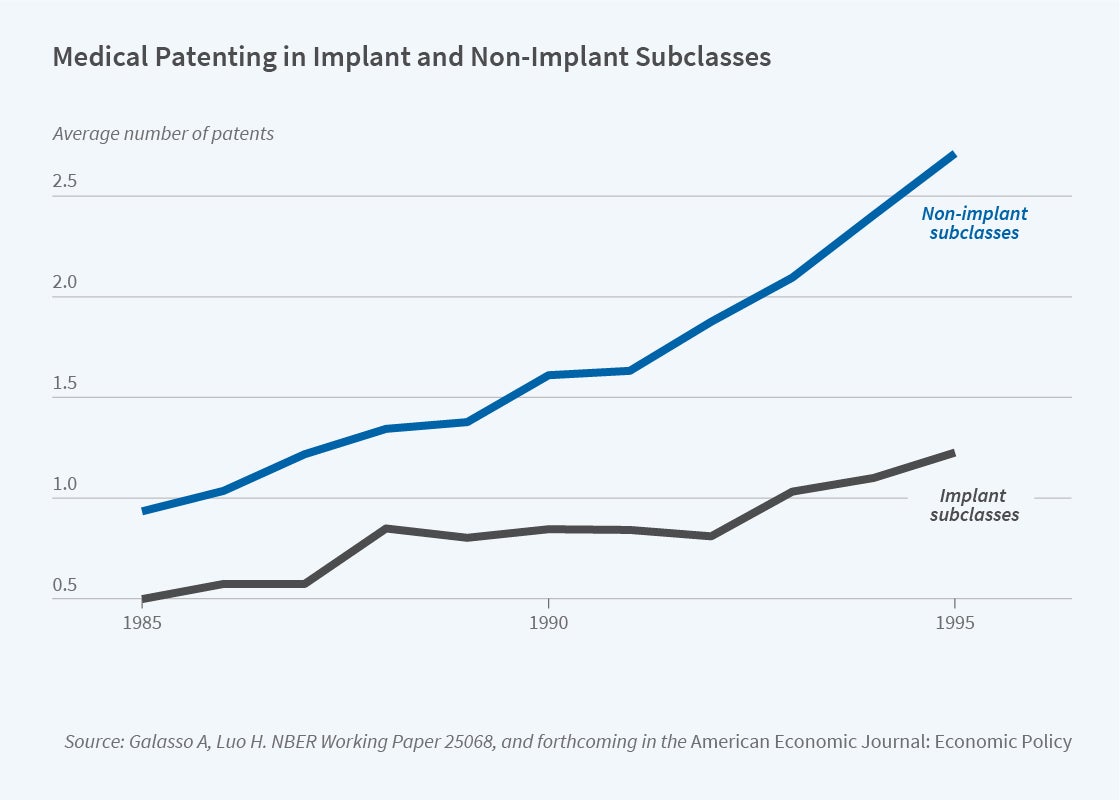Program Report: Law and Economics, 2022
The Law and Economics Program emphasizes economic analysis of processes within courts, legislatures, and government agencies, as well as of the effects and causes of substantive legal rules in the foundational legal subjects of property law, criminal law, contract law, and tort law. Program members meet twice annually, once at a midyear program meeting and again at the NBER Summer Institute.
This article first describes recent research on legal processes and in the foundational legal subjects. It then examines work on the causes and effects of substantive legal rules in the additional areas of consumer financial protection, corporate law, and workplace law.
The Operation of Legal Processes
The operation of legal processes, particularly in courts, is a core emphasis of the program. The operation of these processes in criminal cases in particular has been a focus in recent years as concerns with racially disparate effects of the criminal justice system have grown. Research by David Arnold, Will Dobbie, and Crystal Yang examines the impact of criminal defendants’ race on the decisions of judges charged with setting bail requirements.1 The researchers find that Black defendants are 3.6 percentage points more likely to have to post bail than their non-Black counterparts. Moreover, among defendants required to post bail, bail judges require Black defendants to post amounts that are $9,923 greater on average than those required of non-Black defendants. As Arnold, Dobbie, and Yang note, it is sometimes suggested that racially disparate bail amounts may reflect underlying differences in the risk of misconduct across different groups. The researchers find, however, that marginally released non-Black defendants are 22.2 to 23.1 percentage points more likely to be arrested for pretrial misconduct than marginally released Black defendants. Given this finding, the greater stringency of bail judges’ treatment of Black defendants is not well explained by reference to higher misconduct within this group of defendants.
Judges on state supreme courts have been a consistent focus of the program. In recent research, Elliott Ash and W. Bentley MacLeod examine the effects of nonpartisan as opposed to partisan state supreme court judge selection on judicial quality, as measured by forward citations to judges’ written opinions.2 In contrast to federal judges, who are appointed via presidential nomination and confirmation by the US Senate, state supreme court judges are often elected, at times in partisan elections. Ash and MacLeod identify quality effects of nonpartisan selection of state supreme court judges by means of changes in many states, over the course of the second half of the twentieth century, from partisan judicial elections to nonpartisan selection. Because state supreme court judges enter service at different times, the researchers compare judges who are working at the same time in the same court but who were selected in different manners. Nonpartisan selection occurs either through technocratic merit selection, often by senior judges, or through election via ballots that do not state a party affiliation for judicial candidates. Because state supreme court judges author opinions resolving issues appealed from lower courts but do not themselves conduct trials, the judges’ opinions — their core work product — can be used to construct measures of judicial performance. Ash and MacLeod find significantly higher levels of forward citation to opinions by judges chosen via nonpartisan selection, especially those chosen through technocratic merit selection, than to opinions by judges chosen via partisan selection.
An important research focus of the program is the operation of legal processes within civil litigation. Within this system, a private party may bring a lawsuit that lacks merit but nonetheless can result in the extraction of a settlement from the party that has been sued. This is so because defending a lawsuit is costly and because the US system, in a departure from its British antecedent, does not allow costs to be recovered from the losing side.
Recent research by Albert Choi and Kathryn Spier models the role of financial market opportunities in increasing the risk that a meritless lawsuit can result in a positive settlement for the party bringing suit.3 As a motivating example, the researchers offer the juxtaposition of hedge fund manager Kyle Bass’s litigation challenging pharmaceutical patents with his taking short positions in the shares of companies whose patents he was challenging. Taking a short position means an actor can credibly threaten to pursue a lawsuit even when the damages the actor bringing the lawsuit expects to recover are lower than this actor’s litigation costs. The reason that taking a short position can have this effect is that the expected damages that must be paid to the actor who brought the lawsuit reduce the value of the defendant firm, which produces a further gain to the actor who pursued the lawsuit while taking a short position. In effect, the proceeds from the short sale subsidize the litigation costs of the actor filing the lawsuit, allowing this actor to profit from a suit that the actor otherwise would not bring. Choi and Spier’s analysis aligns with other law and economics work exploring how third-party interactions can strengthen the hands of litigants in battling their opponents.
Property, Criminal, Contract, and Tort Law
The racial impact of the criminal justice system spans not just the operation of processes such as bail-setting but also the substance of what is criminalized. A particularly important topic in current debates over criminalization is the effect of criminalizing minor infractions. Recent work by Amanda Agan, Jennifer Doleac, and Anna Harvey presents evidence of the impact of a presumption of nonprosecution of certain nonviolent misdemeanors on defendants’ future criminal behavior; reducing criminal justice system contact for minor infractions through such a presumption may produce overall improvements in public safety.4 Instrumenting for nonprosecution with a Massachusetts policy change under which 15 specified nonviolent misdemeanors — the “Rollins list” — are presumptively nonprosecuted, the researchers find that nonprosecution significantly decreases the rate at which defendants face new criminal complaints in the following year. As shown in Figure 1, decreases are observed in response both to the absolute level of nonprosecution of nonviolent misdemeanors and to the level of nonprosecution of nonviolent misdemeanors relative to nonviolent felonies. The researchers’ analysis also examines data from the period prior to establishment of the presumption of nonprosecution for Rollins list misdemeanors; in this part of the analysis, the researchers use assignment of a defendant’s case to a “lenient” prosecuting attorney as an instrument for nonprosecution and find again that nonprosecution significantly decreases the rate of new criminal complaints.

Some behavior that society seeks to deter is not criminalized but instead is made the basis of tort liability. A prominent illustration of tort liability is that for selling products that threaten serious harm; such behavior by firms can give rise to products liability, a very large component of tort liability in the United States. Large damage awards in products liability cases have raised concerns that such liability may exert a substantial chilling effect on innovation. Alberto Galasso and Hong Luo explore the effects of products liability on innovation by examining medical patenting after large-scale lawsuits filed by silicone breast implant and temporomandibular joint (TMJ) jaw implant recipients in the late 1980s.5 The researchers report that this period featured a relative decline in medical implant patenting compared to patenting in non-implant medical device technologies, as Figure 2 shows. FDA applications similarly suggest that in this period medical implant innovation experienced a decline relative to other medical device innovation. The researchers also consider the effects of the Biomaterials Access Assurance Act, a 1998 law designed to restore incentives for medical implant suppliers. Galasso and Luo suggest that patenting dynamics similar to those they study may occur in other technology-oriented industries associated with significant risk, such as transportation and energy.

Consumer Financial Protection, Workplace Law, and Corporate Law
An extremely active area of contemporary research in the program is consumer financial protection. In recent work, Tal Gross, Raymond Kluender, Feng Liu, Matthew Notowidigdo, and Jialan Wang analyze the effects of the Bankruptcy Abuse Prevention and Consumer Protection Act of 2005.6 This law placed a number of new limitations on filing for bankruptcy. The researchers find that bankruptcies fell by half in the two years following the law’s effective date compared to the two years prior to its effective date. This result includes an adjustment for the last-minute rush to file before the law went into effect. The researchers find that 60 to 75 percent of the cost savings of the reduced likelihood of credit card debt being discharged through bankruptcy was passed along to consumers in the form of reduced interest rates.
Workplace law has long been a focus of the program. Recent work by Mason Ameri, Lisa Schur, Meera Adya, F. Scott Bentley, Patrick McKay, and Douglas Kruse investigates the efficacy of disability discrimination law via a field experiment involving responses to job openings for accounting positions with applications that either did or did not reference disability.7 Examining responses from applicants with versus without a spinal cord injury, the researchers find that the probability of a positive employer reply (such as an interview, a request for further documents or credentials, or a request for a further action by the applicant) was 4.80 percent for the former group compared with 6.58 percent for the latter group, despite the fact that a spinal cord injury would be unlikely to have a significant productivity effect in the accounting positions targeted by the applications. Further disaggregating by employers above versus below the coverage threshold for the Americans with Disabilities Act (ADA) prohibition on disability discrimination in employment, the researchers find a significantly lower probability of a positive employer reply to an applicant with a spinal cord injury among employers below the ADA’s 15-employee coverage threshold relative to employers above that threshold.
Corporate law has been a longstanding centerpiece of the program. In recent work, Lucian Bebchuk and Doron Levit offer a model that addresses the effect of legal responses to the presence of short-term shareholders.8 An example of such a response is the Securities and Exchange Commission’s 2010 exclusion of short-term shareholders from the agency’s proxy access rule. Many commentators and policymakers have suggested that short-term shareholders are unlikely to support policies and approaches that maximize firms’ long-term value. Bebchuk and Levit’s model endogenizes choices of such policies and approaches, and it shows that short-term shareholding does not reduce firms’ long-term value. Because firms’ policies and approaches are observable, choices that reduce firms’ long-term value will also reduce the market prices received by short-term shareholders. The researchers note the importance of securities laws’ disclosure requirements to this result.
Endnotes
“Racial Bias in Bail Decisions,” Arnold D, Dobbie W, Yang C. NBER Working Paper 23421, May 2017, and Quarterly Journal of Economics 133(4), November 2018, pp. 1885–1932.
“Reducing Partisanship in Judicial Elections Can Improve Judge Quality: Evidence from U.S. State Supreme Courts,” Ash E, MacLeod WB. NBER Working Paper 22071, revised June 2021, and Journal of Public Economics 201 (2021), 104478.
“Taking a Financial Position in Your Opponent in Litigation,” Choi A, Spier K. American Economic Review 108(12), December 2018, pp. 3626–3650.
“Misdemeanor Prosecution,” Agan A, Doleac J, Harvey A. NBER Working Paper 28600, March 2021.
“When Does Product Liability Risk Chill Innovation? Evidence from Medical Implants,” Galasso A, Luo H. NBER Working Paper 25068, September 2018, and American Economic Journal: Economic Policy (forthcoming).
“The Economic Consequences of Bankruptcy Reform,” Gross T, Kluender R, Liu F, Notowidigdo M, Wang J. NBER Working Paper 26254, revised November 2019, and American Economic Review 111(7), July 2021, pp. 2309–2341.
“The Disability Employment Puzzle: A Field Experiment on Employer Hiring Behavior,” Ameri M, Schur L, Adya M, Bentley FS, McKay P, Kruse D. ILR Review 71(2), March 2018, pp. 329–364.
“Should Short-Term Shareholders Have Less Rights?” Bebchuk L, Levit D. January 2019, presented at 2019 NBER Law and Economics program meeting. https://conference.nber.org/conf_papers/f117084.pdf.


